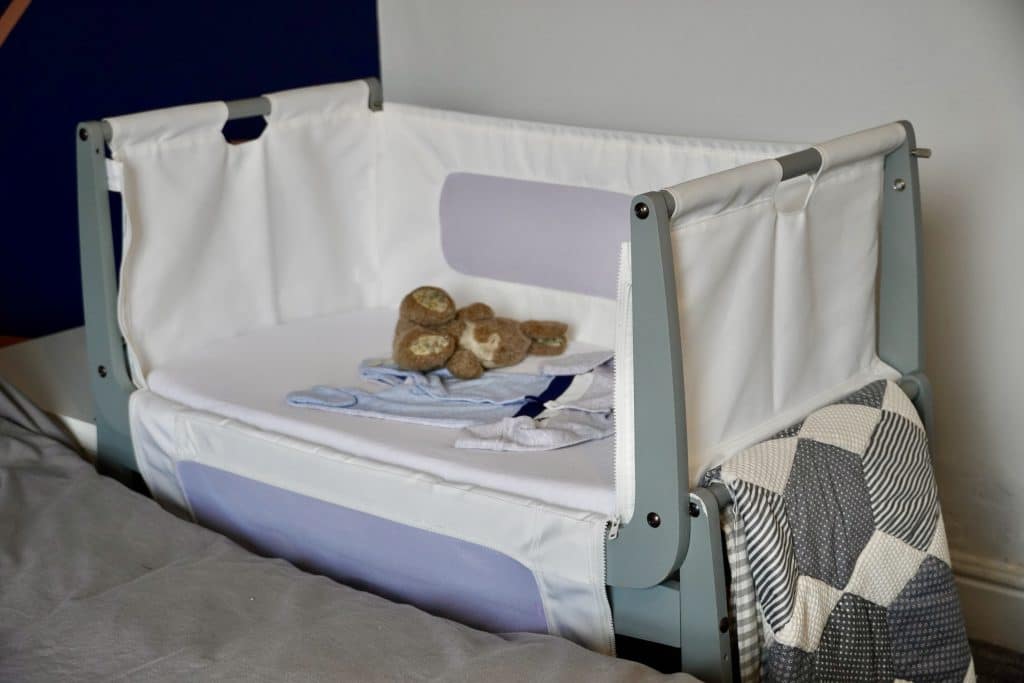Do I Really Need a Moses Basket? – Everything You Need To Know & Why
Some of the links below are affiliate links. As an Amazon Associate, I earn from qualifying purchases. This means that, at zero cost to you, I will earn an affiliate commission if you click through the link and finalize a purchase.
Before your new baby arrives, you’ll need to decide where and how he’ll sleep. Some parents choose to keep their baby close all night in a co-sleeping pod, while others put their baby in a cot in his own room. Another option is to have your baby sleep in a Moses basket beside your bed.
You will need a Moses basket if you plan to share a room with your baby during his first few months of life. A Moses basket is space-efficient and offers plenty of room in and around the bed so that you can sleep comfortably. It can also keep your baby cozy and safe throughout the night.
If you’re still debating the pros and cons of purchasing a Moses basket, keep reading. This guide will walk you through the benefits and drawbacks of a Moses basket and alternatives that might work better for you and your baby instead.
What Is a Moses Basket?
A Moses basket (also known as a bassinet) is a small bed for newborn babies. It’s smaller than a cot and is placed in the parents’ bedroom instead of the nursery. Moses baskets are designed for newborn safety with a firm mattress and sides made of wicker or similar light and breathable materials.
Many Moses baskets attach to stands so that your baby is at an accessible height for you. However, not all baskets come with a stand included, and you may have to purchase a stand separately. You can easily detach the basket from the stand and use it as a way to carry your baby around the house, moving them from one room to the next without waking them.
What Age Can You Use a Moses Basket?
You can use a Moses basket from birth until your baby outgrows it or until he’s three to four months old. Some larger babies outgrow the Moses basket much quicker. Most Moses baskets can hold babies that weigh up to 10 kg (22 lbs).
When your baby starts running out of room in the Moses basket, or when he can roll around, it’s time to move him to a larger bed such as a cot. Additionally, once your baby starts requiring a quiet, isolated sleeping environment, your Moses basket should be retired.
The NHS recommends sharing a room with your baby until he’s at least six months old. Because your baby will outgrow the Moses basket by three or four months, you may want to consider moving his cot into your room or using a co-sleeping cot or sleep pod at that point.
What Are the Benefits to Using a Moses Basket?
The main benefit of using a Moses basket is sharing a room with your baby if you don’t have much space. Moses baskets help keep your newborn close during the night and, because they’re quite small, they don’t take up much floor space. They’re also easy to move around the house.
Room-sharing with your newborn reduces the risk of health complications and allows parents to easily tend to their baby in the middle of the night. Nursing mothers can take care of nighttime feedings without having to leave the room. Room-sharing also gives parents peace of mind and babies better, safer sleep.
Moses baskets also allow you to enjoy the benefits of room-sharing without sacrificing your personal space in the bed. Parents who move a lot in their sleep may find that sleeping pods or bedside cribs get in their way. A Moses basket keeps your baby close through the night without taking up your personal space.
Newborn babies spend most of their time asleep, even if they’re in a room with distractions. A Moses basket is easy to carry from one room to the next, so you can have your baby nap in any room with you.
What Are the Drawbacks to Using a Moses Basket?
The primary drawback of a Moses basket is that you’ll only get a maximum of four months of use from it, and many parents choose to share a room with their baby for longer than that. A Moses basket is not a complete solution if you want to room-share for the recommended six months or longer.
You may not get much use out of a Moses basket, depending on the size of your baby. You have no way of knowing how big your baby will be and how quickly he’ll grow. Some babies can sleep in their Moses baskets for a full four months, while others outgrow them after one month. It all depends on the baby and the Moses basket.
Additionally, if you want to continue room-sharing after four months (or whenever your baby outgrows the Moses basket), you’ll have to invest in another bed for your baby. You can move your baby’s crib to your room, provided there’s enough space, or use a travel cot. Both of these choices take up much more room than a Moses basket.
Are There Any Alternatives to Moses Baskets?
There are numerous alternatives to Moses baskets, such as co-sleeping cribs, baby nests, cots, and travel cots. These can also come in handy once your baby has outgrown the Moses basket.
Co-Sleeping Crib
Co-sleeping cribs (also known as bedside cribs or side-sleeper cribs) are larger than Moses baskets but smaller than traditional cots. These cribs attach to the side of your bed, letting you stay close to your baby without the safety risks of traditional co-sleeping. Most co-sleeping cribs have a foldable side, so they can be used as a standalone cot if necessary.
These cribs can be used from birth up to six months of age and sometimes for even longer. They are roomier than Moses baskets and have higher sides, making them safe to use for babies older than four months.

Some co-sleeping cribs have wheels so parents can move them from room to room. They aren’t as portable as Moses baskets, but they’re easier to move than regular cots. Co-sleeping cribs often have mesh siding, so it’s easy to watch your baby even when you’re using it as a standalone cot.
Keep in mind that not all beds are compatible with co-sleeping cribs. Co-sleeping cribs can’t safely attach to particularly tall or short bed frames. Parents who move a lot in their sleep or who get up often in the middle of the night may find a co-sleeping crib gets in their way.
A co-sleeping crib will be more expensive than a Moses basket, but it’ll also last longer. If you’re considering a co-sleeping crib, check out the Chicco Next2Me family of cribs available on Amazon.co.uk. Not only are they comfortable, some options even have a rocking function to help you soothe your baby to sleep.
Baby Nest
Baby nests (also known as co-sleeping pods) are used for co-sleeping, daytime lounging, and even nappy changes. Your baby sleeps in your bed in the safety of the nest, surrounded by a firm, cosy foam. You can easily nurse your baby throughout the night as needed, and you can check on him periodically without leaving the bed.
One of the biggest advantages of using a baby nest is its portability. It’s small, easy to transport, and doesn’t take up any floor space. Baby nests allow parents to room share even if their bedrooms are too small for a cot or Moses basket.
Baby nests shouldn’t be used unsupervised, and you should never leave your baby in the nest on your bed without you there. For naps, you should place your baby in a cot without the nest. Parents who move in their sleep may not be comfortable sleeping in bed with a baby nest, either.
Follow the instructions on your baby nest for safety guidelines. Some baby nests aren’t intended for sleep, so be sure to read the specifications on your nest carefully. Two of the most popular baby nests are the DockATot Deluxe+ Dock and the Babymoov Cosydream, both of which are available on Amazon.co.uk.
Travel Cot Bassinet Attachment
Some travel cots, play yards, and pack and plays have attachments that can double as a bassinet. If you have the space in your room for a travel cot, consider setting one up with a changing pad and bassinet attachment.
The Graco Contour Electra Travel Cot on Amazon.co.uk is a great example. Your baby can sleep in the bassinet attachment until he outgrows it. Then, you simply remove the attachment and lay him to sleep in the cot below. The changing pad attachment also means you don’t need to purchase a changing table.
The challenge with this product is that you won’t be able to carry your sleeping baby from room to room as you would with a Moses basket. You also need to have a fair amount of space in your bedroom for a travel cot. However, beyond these two concerns, a travel cot is a practical, efficient alternative to a Moses basket.
Cot
A cot is the easiest and most practical way to keep your baby safe at night. You can place the cot in your room or the nursery, depending on whether or not you want to room-share. Your newborn should be safe as long as the cot is flat, firm, and free of blankets and toys.
If you’re not looking for anything fancy, a cot is all you need for your baby to sleep safely. It should last you several years until your child is ready to transition to a bed. A full-size cot may not be the most elegant solution, but it’s both practical and cost-effective.
The biggest drawbacks of using a cot over a Moses basket are size and mobility. A cot is the largest, most unwieldy sleeping option for your baby. You won’t be able to move it easily around your home, and you can’t take it with you when you travel. You will also need a lot of space in your bedroom if you want to room-share with your baby.
Do I Need a Moses Basket?
You need a Moses basket if you want to share a room with your newborn and don’t have much space in your bedroom. This small, portable cot will allow you to room-share with your baby for the first few months of his life. However, keep in mind that children will outgrow a Moses basket quickly.
If you want to continue room-sharing beyond four months, you’ll need to invest in another sleeping option for your baby.
You won’t need a Moses basket if you don’t want to share a room with your baby or if you have the space for a cot in your room. Additionally, if you find a co-sleeping kit or travel cot more convenient for room sharing, a Moses basket will be redundant.
Fortunately, most Moses baskets are relatively inexpensive, so if you purchase one and don’t like it, it’s not a huge waste of money or space.
